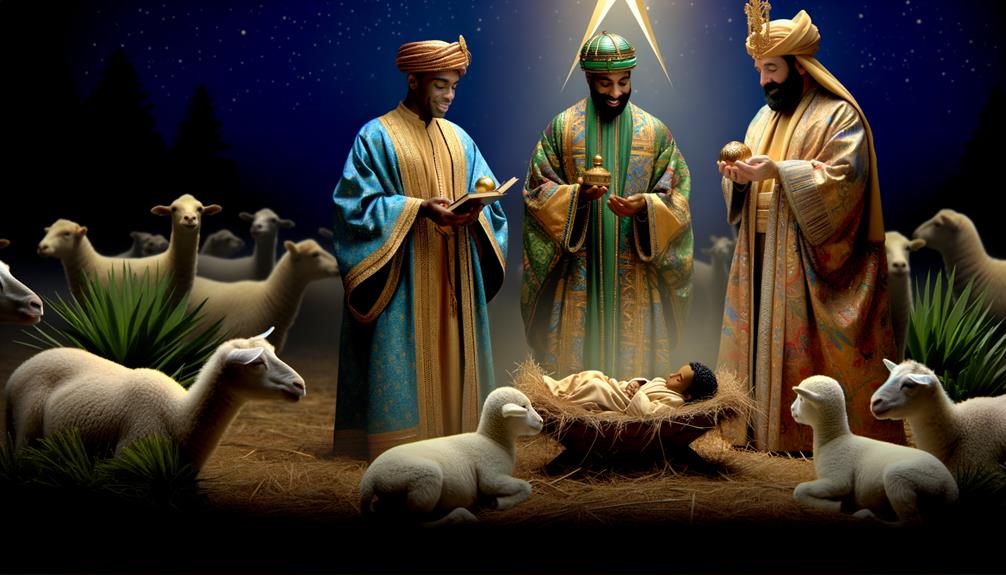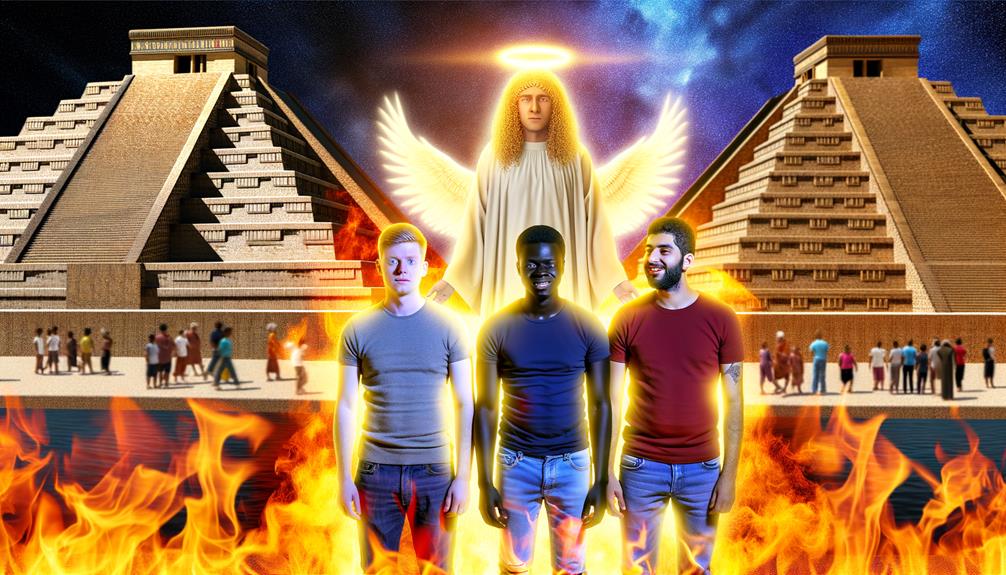Symbolic Meaning of Number 3 in the Bible: Completeness
In the Bible, the number three symbolizes divine completeness, perfect unity, and transformative power. The Holy Trinity—Father, Son, and Holy Spirit—embodies unity within the Godhead.
Jesus’ resurrection on the third day underscores victory over death and inaugurates a new covenant. Jonah’s three days in the fish highlight repentance and renewal, while Peter’s three denials emphasize themes of human frailty and redemption.
Additionally, the three patriarchs (Abraham, Isaac, Jacob) encapsulate divine promises. Instances like Daniel’s companions in the fiery furnace exhibit divine protection.
These examples reveal the deep, multifaceted symbolism of the number three, opening avenues for further exploration.

Symbolic Meaning of Number 3 in the Bible: Divine Completeness, Trinity, and Resurrection
| Aspect | Biblical Meaning |
|---|---|
| Divine Completeness & Perfection | The number 3 symbolizes divine completeness and perfection, often representing the wholeness of God’s work and purpose (Genesis 6:10, Ecclesiastes 4:12). |
| Holy Trinity | The most significant symbolism of the number 3 is the Holy Trinity: Father, Son, and Holy Spirit, highlighting God’s triune nature (Matthew 28:19). |
| Resurrection & New Life | The number 3 is associated with resurrection and new life, as seen in Jesus rising from the dead on the third day, symbolizing victory over death and sin (1 Corinthians 15:4). |
| Repetition for Emphasis | In the Bible, repeating something three times emphasizes its importance, such as “Holy, Holy, Holy” to describe God’s supreme holiness (Isaiah 6:3, Revelation 4:8). |
| Divine Presence & Revelation | Key events often occur in sets of three, such as Jonah being in the fish for three days, Peter denying Jesus three times, and Jesus praying three times in Gethsemane, symbolizing divine presence and pivotal moments (Jonah 1:17, Matthew 26:34, Matthew 26:44). |
The Holy Trinity

The concept of the Holy Trinity is perhaps the most profound illustration of the symbolic significance of the number three in the Bible, encapsulating the unity of the Father, the Son, and the Holy Spirit.
This triune nature suggests a complete and perfect unity within the Godhead, each person distinct yet consubstantial and coeternal.
The symbolism of three here underscores divine completeness and harmony, reflecting a theological and metaphysical depth that has been pivotal in Christian doctrine.
The triadic structure offers a framework for understanding the complex relationship between God’s transcendence, immanence, and mediation.
It signifies not only balance and order but also the profound mystery intrinsic to divine nature, fostering a deeper comprehension of Christian theological principles.
Jesus’ Resurrection

The resurrection of Jesus Christ on the third day carries profound theological implications, fulfilling the three-day prophecy and symbolizing divine perfection.
This event not only underscores the scriptural emphasis on the number three but also represents Christ’s triumphant victory over death.
Analyzing these dimensions reveals the multifaceted significance of the number three within the context of Christian doctrine.
Three-Day Prophecy Fulfilled
In the New Covenant, Jesus’ resurrection on the third day serves as a pivotal fulfillment of the three-day prophecy, underscoring its profound theological significance. This event not only validates Jesus’ divine authority but also affirms the scriptural promises, reflecting a pattern of divine action in threes. The resurrection, occurring on the third day, symbolizes victory over death and the inauguration of a new covenant between God and humanity.
| Event | Day 1 | Day 3 |
|---|---|---|
| Jonah in the Whale | Initial Descent | Deliverance |
| Jesus’ Crucifixion | Death | Resurrection |
| Israel at Sinai | Preparation | Covenant Ratification |
This triadic structure emphasizes the completion and transformation inherent in biblical narratives.
Divine Perfection Symbolized
Symbolizing divine perfection, Jesus’ resurrection epitomizes the ultimate manifestation of God’s redemptive power and the consummation of His divine plan. The third day, as a scriptural motif, underscores the significance of Christ’s resurrection within the broader theological framework of divine fulfillment.
This event is emblematic of divine perfection for several reasons:
- Completion of Prophecy: Jesus’ resurrection on the third day fulfills Old Scriptures prophecies.
- Trinitarian Symbolism: It aligns with the triune nature of God—Father, Son, and Holy Spirit.
- Redemptive Fulfillment: It signifies the completion of God’s plan for human redemption.
- Divine Authority: It demonstrates God’s supreme authority over life and death.
This symbolic triad reflects theological completeness and divine perfection.
Triumphant Victory Over Death
Beyond representing divine perfection, Jesus’ resurrection also signifies His triumphant victory over death, a cornerstone of Christian faith and theology.
The number 3 is profoundly symbolic in this situation, as Jesus rose on the third day, fulfilling prophetic scriptures and affirming His divine authority. This triadic event underscores the transformative power of resurrection, illustrating the shift from death to eternal life.
In Christian theology, the third day is not merely a temporal marker but a manifestation of divine intervention and victory over mortal limitations. This symbolic use of the number 3 reinforces the belief in Christ’s power to transcend death, offering hope and salvation to believers, and solidifying the foundation of Christian doctrine and eschatological promise.
Jonah’s Three Days

The narrative of Jonah’s three days in the belly of the great fish serves as a profound period of reflection and transformation, symbolizing a critical juncture of repentance and introspection.
This episode epitomizes divine intervention, highlighting God’s omnipotence and mercy in redirecting Jonah’s path.
The triadic structure here underscores the importance of the number three in biblical contexts, reflecting themes of spiritual renewal and divine purpose.
Time of Reflection
Jonah’s three days in the belly of the great fish serve as a profound period of introspection and transformation, illustrating the significance of repentance and divine mercy. This interval symbolizes an essential time for self-examination and spiritual awakening, a motif recurrent in biblical narratives.
The experience offers several key insights:
- Repentance: Jonah’s ordeal underscores the importance of acknowledging one’s sins.
- Divine Mercy: It highlights God’s readiness to forgive those who genuinely repent.
- Transformation: The period signifies personal and spiritual metamorphosis.
- Isolation: Jonah’s solitude in the fish’s belly represents a space for undisturbed reflection.
These themes collectively emphasize the transformative potential inherent in periods of reflection.
Divine Intervention Significance
In the biblical narrative, the three days Jonah spends in the belly of the great fish serve as a profound instance of divine intervention, illustrating God’s active involvement in guiding and redirecting human lives.
This period is symbolic of a transformative interlude, where Jonah undergoes a process of introspection, repentance, and eventual obedience to God’s will.
The triadic structure emphasizes completeness and divine orchestration, signifying that God’s intervention is both purposeful and restorative.
This episode not only underscores the theme of divine mercy but also highlights the significance of time as a medium through which God enacts His plans.
Consequently, Jonah’s three-day confinement becomes a microcosm of divine patience and the transformative potential inherent in divine-human encounters.
Peter’s Denials

Amidst the narrative of Peter’s denials, the recurrence of the number three underscores a profound symbolic resonance within biblical texts. This triad of denials before the rooster crows, as foretold by Jesus, reflects several layers of theological and moral significance.
- Fulfillment of Prophecy: Peter’s three denials confirm Jesus’ foreknowledge and prophetic accuracy.
- Human Fallibility: The thrice-repeated act highlights human weakness and the tendency to falter under pressure.
- Redemption and Forgiveness: Peter’s subsequent restoration by Jesus, also involving three affirmations of love, underscores divine mercy.
- Completeness and Wholeness: The number three often symbolizes completeness, suggesting a full measure of Peter’s betrayal and subsequent repentance.
This analysis reveals the intricate symbolic layering that enriches biblical narratives.
Three Patriarchs

The significance of the number three is profoundly illustrated through the lives of the three patriarchs—Abraham, Isaac, and Jacob—whose narratives collectively underpin the theological and covenantal framework of the Old Scriptures.
Abraham’s covenant with God marks the inception of a divine promise, symbolizing faith and obedience.
Isaac, as the promised child, epitomizes the fulfillment of God’s covenantal assurances.
Jacob, later named Israel, represents the continuance of this divine promise through his twelve sons, the progenitors of the twelve tribes of Israel.
These three patriarchs are not merely historical figures; they exemplify the triadic progression of God’s unfolding plan for humanity, thereby embedding the number three with profound theological and symbolic resonance within the biblical narrative.
Three Temptations

How does the episode of the three temptations of Christ in the wilderness encapsulate the recurring biblical theme of testing and divine fidelity? This narrative, found in the Gospels, reveals profound insights into spiritual resilience and obedience.
Each temptation presented by Satan challenges Jesus to:
- Turn stones into bread, signifying physical sustenance.
- Leap from the temple’s pinnacle, testing divine protection.
These trials underscore the motif of threefold testing, mirroring other biblical instances where faith is examined.
Christ’s steadfast refusal to succumb highlights the intrinsic value of unwavering trust in God’s will. This triad of temptations also serves as a foundational model for understanding the nature of spiritual warfare and divine loyalty.
Three Gifts of Magi

The three gifts presented by the Magi—gold, frankincense, and myrrh—carry profound symbolic meanings within the biblical narrative.
Gold is traditionally associated with kingship and divinity, signifying Jesus’ royal status.
In contrast, frankincense and myrrh are imbued with spiritual and mortuary connotations, respectively, reflecting aspects of Jesus’ priestly role and foreshadowing his sacrificial death.
Gold’s Symbolic Significance
Among the three gifts presented by the Magi, gold holds profound symbolic significance, often interpreted as a representation of kingship and divinity in biblical exegesis. This precious metal serves as a multi-faceted symbol within the context of scripture. Its inclusion by the Magi underscores multiple layers of meaning:
- Royalty: Gold traditionally signifies wealth and kingship, aligning with Jesus’ identity as the ‘King of Kings.’
- Divinity: Gold’s purity and imperishability represent divine nature and eternal sovereignty.
- Offering: It reflects the acknowledgment of Jesus’ supreme status and homage from the wise men.
- Prophetic Fulfillment: The gift fulfills prophecies, linking Jesus to Old Testament messianic expectations.
Such dimensions enrich the theological understanding of gold’s symbolic import.
Frankincense and Myrrh Meanings
Frankincense and myrrh, alongside gold, each carry profound symbolic meanings that contribute richly to the theological tapestry of the nativity narrative.
Frankincense, an aromatic resin, symbolizes divinity and priesthood, reflecting Jesus’ role as the ultimate high priest who bridges the divine and human domains.
Myrrh, a substance used in embalming, foreshadows Jesus’ mortality and sacrificial death, encapsulating the dual nature of his mission as both divine and human.
These gifts, presented by the Magi, not only honor Jesus but also encapsulate key aspects of his identity and purpose.
Their inclusion underscores the depth of the incarnation mystery, intertwining themes of divinity, sacrifice, and kingship within the broader biblical narrative.
Threefold Blessing

In biblical literature, the concept of a threefold blessing frequently symbolizes the completeness and divine perfection inherent in God’s providence. This motif underscores the holistic nature of God’s favor, reflecting His encompassing grace and care. The threefold blessing is evident in various scriptural passages, illustrating its theological significance.
- Priestly Blessing: Numbers 6:24-26 features a tripartite blessing invoking God’s protection, grace, and peace.
- Abraham’s Promise: Genesis 12:2-3 delineates blessings of nationhood, renown, and universal benediction.
- Isaiah’s Vision: Isaiah 6:3 captures the seraphim’s thrice-holy proclamation, signifying God’s supreme holiness.
- Ecclesiastes’ Cord: Ecclesiastes 4:12 emphasizes the strength of a threefold cord, symbolizing unity and resilience.
This pattern reaffirms the number three’s sacred resonance in biblical theology.
Daniel’s Companions

Daniel’s three companions—Shadrach, Meshach, and Abednego—exemplify steadfast faith and divine protection in the face of persecution, as narrated in the Book of Daniel. Their refusal to worship King Nebuchadnezzar’s golden image led them to be cast into a fiery furnace, a trial by fire that underscores their unwavering devotion to God.
The miraculous preservation of these three men, witnessed by an astonished king who saw a fourth figure ‘like a son of the gods’ (Daniel 3:25), serves as a profound witness to the power of divine intervention.
Symbolically, the trio embodies the completeness of faith and the divine triad, reinforcing the theme of God’s protection and the sanctity of unwavering belief amidst trials.
Three Days of Darkness

The motif of three days of darkness in the Bible symbolizes periods of divine judgment, change, and profound spiritual significance. This recurring theme is evident in various scriptural accounts, each imbued with deep theological implications.
- Plague of Darkness in Egypt: Represents God’s judgment against Pharaoh and the gods of Egypt (Exodus 10:21-23).
- Jonah in the Belly of the Fish: Symbolizes repentance and change (Jonah 1:17).
- Jesus’ Time in the Tomb: A period of death and resurrection, marking the new covenant (Matthew 12:40).
- Paul’s Blindness: Spiritual awakening and mission initiation (Acts 9:9).
These instances highlight the number three as a powerful emblem of significant changes within the biblical narrative.
Abraham’s Visitors

Among the numerous biblical narratives, the story of Abraham’s visitors stands out as a profound example of divine encounter and its symbolic implications.
In Genesis 18, Abraham is visited by three men, who are often interpreted as a manifestation of God or His messengers. The number three here is symbolically significant, representing the divine presence and communion.
The trio’s visit heralds the promise of Sarah’s miraculous conception, underscoring themes of faith and divine intervention. Additionally, the triadic presence can be seen as a precursor to the Christian concept of the Holy Trinity.
This episode emphasizes the importance of hospitality and reverence towards divine messengers, reinforcing the deeper theological undertones associated with the number three in biblical literature.
Conclusion
The number 3 in the Bible carries profound symbolic significance, often representing completeness and divine perfection. The number 3 is often associated with the Holy Trinity in Christianity, representing the Father, Son, and Holy Spirit. Additionally, it is also seen as a symbol of unity, harmony, and balance. Similarly, the symbolic meaning of number 12 is also significant in the Bible, often representing governmental perfection and divine authority, as seen in the 12 tribes of Israel and the 12 apostles chosen by Jesus. Both numbers carry deep spiritual meanings and are often used to convey divine messages and truths in biblical texts.
For instance, the resurrection of Jesus Christ after three days signifies both the fulfillment of prophecy and the triumph over death, embodying a profound metaphor for spiritual rebirth.
This recurrent motif, evident in narratives such as Jonah’s entrapment in the fish and Peter’s three denials, underscores the theological importance of this number in conveying pivotal moments of transformation and divine intervention.






